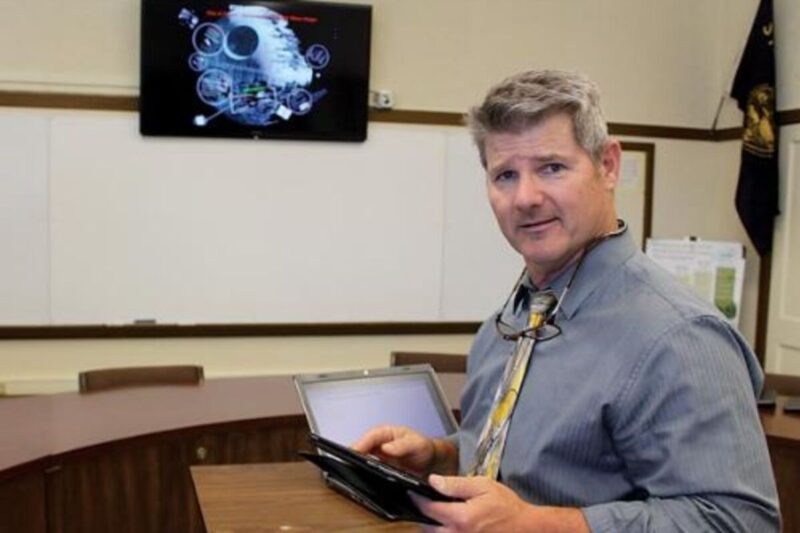Sean C. Morgan
It’s the 21st century, and teachers and students ought to have something like an iPad in their hands throughout the School District, according to Supt. Don Schrader.
He’s working on that.
The district has a new 60-inch flatscreen TV installed in the board room at the Central Office, along with about 30 iPads. With Apple TV and a wireless network, they’re all interconnected.
The TV and 15 of the iPads were purchased through a federal Title VI grant to improve the digital learning experience.
“We’re supplementing what’s going on in the classroom,” Schrader said.
With Apple TV, if they’re on the same network, the TV can reflect what’s on an iPad, he said. The TV can be used for presentations controlled by an iPad. Right now, the system is available for teachers to teach other teachers and for classrooms.
“First, we’re going to teach our teachers to use the devices,” Schrader said, as he used the TV to monitor his iPhone’s screen. Eventually, he wants to have students using their own devices.
The system is set up for Apple products, but Android- and Windows-based devices can join the system through web-based programs and applications.
Interconnecting each kind of device is important, he said. For instance, blocking filters need to allow access properly. As Schrader was demonstrating the project recently, the district’s network was blocking mentimeter.com, a site he is using as part of his presentation and demonstration, on an Android device.
Access needs to be clear, he said. “We need to open it up. If we don’t, kids won’t be able to do this. If I can’t be wireless any time, any place in this district, we’re not going to get there.”
Every part of every building needs wireless, he said. Ideally, access to the wireless network should be as automatic and as easy as accessing the networks at Starbucks.
“The kids are digital natives,” Schrader said. That’s why teachers need to get up to date. He noted that the new, younger teachers are often coming into the district already connected, and the district can probably learn something from them.
In addition to interactive websites and applications useful for activities in classrooms, modern technology provides opportunities with programs like iTunes U. Users can take a variety of classes through it.
“I decided to enroll in a Shakespeare course because I wanted to know more about Shakespeare,” Schrader said.
Five-minute Spanish?
The iTunes University has it.
Schrader and the district’s technical staff and teachers are trying to put together a package of useful applications for teachers, Schrader said. He hopes that teachers will bring their own, which are useful in the classroom for teachers or for engaging students, to a binder full of applications
“Ultimately, I’d like to get where kids walk into a classroom and they pick up an iPad,” Schrader said. “If we’re going to teach in the 21st century, we’ve got to think that way.”
The classroom is still using 18th- and 19th-century technology, with students sitting in rows and writing with pencils, he said. Right now, schools have labs for higher technology.
“Did they use labs for pencils?” Schrader asked. “A computer should be in every classroom. That’s moving into the 21st century. Our classrooms should be computer labs.
“The teachers are using it as a tool for teaching, and kids are using it for learning.”
“Smart boards” have been around for a long time, he said. Now, the district has smart boards that should and do fit into the hand.
“We’re putting together a technology task force,” he said. It includes some classified staff, teachers, a principal or two, Schrader and Business Manager Kevin Strong, along with board member Mike Reynolds and others from the community to research the existing system and determine how to get it where it needs to go.
Schrader has had an analyst assess the district’s network, and the infrastructure is already in place, Schrader said. The district just needs to get the wireless and access opened up more.
In the meantime, iPads can be checked out by teachers for use in the classroom or to give presentations to other teachers on ways to use the iPads in the classroom.
Yes, the devices might be disruptive in classrooms, he said. At the same time, students already have the disruptive devices, but it’s still something the district will need to watch. He hopes classroom devices become a non-disruptive, ubiquitous and useful tool like a pencil and paper, which also can disrupt classrooms when students write and pass notes.
“I’m just really excited this is something we’re going to be leaning toward,” Schrader said.





